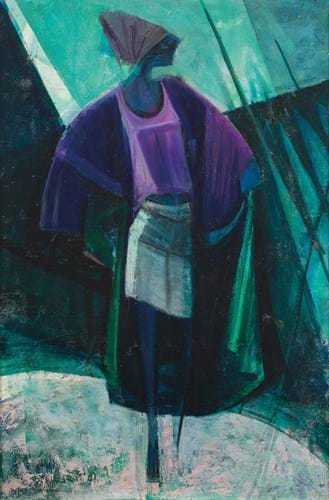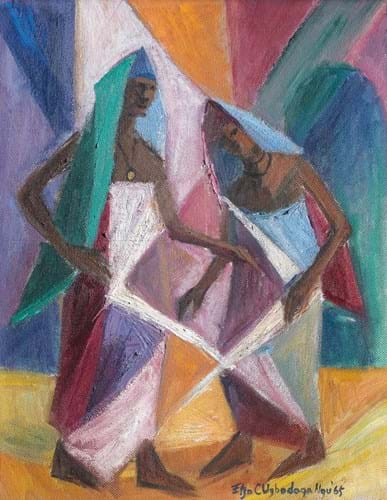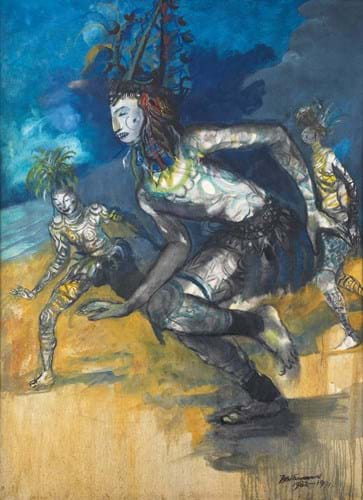How many sectors of the art and antiques market are growing at 7% or more? Although for many collectors investment is not the main reason for buying, the current rate of inflation in the UK means that unless objects are rising by this amount per year they are losing value in real terms.
When it comes to art specifically, those assessing where to place their money currently are therefore more tempted by markets offering high returns.
These tend to be the so-called ‘new’ markets such as Contemporary art – going against the more traditional school of thought that states that the ‘gold standard’ sectors like Old Masters and top-ranking Impressionist and Modern artists represent the best place to hold value over the long term.
Even some experienced investors are now looking carefully at these more speculative areas as part of a diversified strategy to protect the value of their overall stock from being eroded by rising inflation.
Plenty of speculative money has been ploughing into the Contemporary art market over the last three decades or so – this is nothing new. But one sub-sector which has more recently come to the attention of investors and collectors alike is modern African art – something that also offers geographical as well as sectoral diversification.
Bonhams (27.5/25/20/14.5% buyer’s premium) began tapping into this field around a decade ago, starting out with Africa Now sales which were borne out of its established sales of South African art in London. Sotheby’s then started its own dedicated sales in 2017.
Bonhams has witnessed considerable growth since launching separate sales in this category and certain artists have fetched extraordinary returns.
Its latest auction in New Bond Street on March 9 underlined this with a host of auction records, although the fact that over 30% of the sale was unsold showed demand is relatively focused on the most bankable names.
Strong figures
Nigerian artist Yusuf Adebayo Cameron Grillo (1934-2021) is a good example. Five years ago, his most distinctive figurative works were fetching a maximum of £100,000-120,000 at auction. They are now making more than double this level.
The three highest prices for the artist were set in 2021, including the £190,000 for Crucifix, an oil on board from 1986 that sold at Bonhams and held the previous record before the current sale.
At the latest auction, an earlier and larger work was on offer. The Dancing Bride dated from the mid-1960s when Grillo was a leading member of the Zaria Art Group, an influential school that was formed by students at the Nigeria College of Arts, Science and Technology. The group is celebrated for the way it rebelled against European artistic conventions and created a modern postcolonial aesthetic.
The current work was executed in the cool blue and purple tones that Grillo favoured in his paintings – based on ‘abide’, an indigo-dyed cloth made in south-west Nigeria and worn by Yoruba women.
The 4ft x 2ft 8in (1.22m x 81cm) signed oil on board came to auction from a private UK vendor and was estimated at £80,000-120,000 – a level showing not just that it was a major work but also a confidence that the market had already moved on in the 12 months since Crucifix was sold.
After strong competition, it was knocked down at £280,000, a sum representing a hefty jump in Grillo’s market and certainly outstripping inflation.
Nigerian art, in particular, seems to be coming into its own at auction. Increasingly, nationalminded buyers from the country are competing against foreign collectors who are now well aware of the investment potential of art from a country with increasing wealth and huge reserves of natural resources (oil and diamonds in particular).
In reference to the current sale, Giles Peppiatt, Bonhams’ director of Modern and Contemporary African art, said: “Clearly works by Nigerian artists in particular captured the attention of the bidders.” He pointed to works by Benedict Chukwukadibia Enwonwu (1917-94) and Clara Etso Ugbodaga-Ngu (1921-96) as evidence of the strong prices now being fetched.
In the case of the latter, Dancers, an 18 x 14in (46 x 36cm) oil on board, was another work by an artist who played an important role in Nigerian art after the country’s independence in 1960.
Born in the northern city of Kano, Ugbodaga- Ngu taught in the region’s schools before gaining a scholarship to study at the Chelsea School of Art and train as a teacher at the London Institute of Education. Returning to Nigeria, she began work as an art teacher with the Nigerian College of Arts, Science and Technology, Zaria, becoming the first Nigerian – and furthermore, the first female – teacher in the department.
Her solo exhibition in 1958 at the Commonwealth Institute Art Gallery, London, was the first art exhibition by a Nigerian female artist in the UK. It was followed by an exhibition in Boston in 1963.
It was rare to see a work by the artist emerging in the West – Ugbodaga-Ngu had no auction record before this sale according to Artprice and the work was, in essence, an example of Bonhams’ ‘introducing’ an artist to the secondary market.
Dancers had been acquired in the mid-1960s by the US ambassador to Nigeria Elbert G Mathews and, having changed hands once since, came to auction from an American collection.
Before the sale Peppiatt described the work as “an extraordinary discovery”, adding that Ugbodaga-Ngu’s paintings “are so rare that I never expected to offer one in my career”.
The painting itself was a complex composition blending Nigerian motifs with semi-Abstract and Cubist forms. Along with the rich palette, it benefited from being signed and dated ‘65’, giving it a key date when her style developed from her earlier experiments more towards portraying the social and cultural history of Nigerian people in the period immediately after independence.
Pitched at £20,000-30,000, it was knocked down at £38,000, establishing a benchmark for the artist at auction. Bonhams will no doubt be hoping that this result will yield more works to the market.
Pioneer of African Modernism
Conversely, works by ‘Ben’ Enwonwu are very much a known proposition, with numerous works having appeared at auction over the last 10 years. Most specialist sales of modern African art will feature at least one work by the artist who is regarded as one of the pioneers of African modernism.
The two oil paintings here made a major contribution to the sale’s bottom line even though they both got away on low estimate, a sign that expectations have risen in the artist’s market.
One of them, My Mama at 80, a 2ft 4 x 19½in (72 x 50cm) oil on canvas, was the artist’s only known painting of his mother and had remained in his family after his death. Selling at £200,000, the sum was still within the top 20 prices for the artist at auction (source: Artprice) and one of the highest for a portrait in a smaller format such as this.
A later work from Enwonwu’s mature period titled Ogolo in Motion sold for the same price against the same £200,000-300,000 estimate. The 3ft 11in x 2ft 11in (1.21m x 88cm) signed oil on canvas depicted the ‘Ogolo’ traditional masquerade that preoccupied Enwonwu throughout his career.
Making numerous drawings, paintings and sculptures relating to the Ogolo from the early 1980s onward, the artist’s interest in masked performance was heightened in 1987 following the death of his eldest brother (masquerades play a significant role in the funerary rites of the Igbo people, including Enwonwu’s family who were based in the city of Onitsha in south-east Nigeria).
After this, he would often return to his earlier unfinished canvases to complete them with renewed vigour. Such was the case here as the work was begun in 1982 and then finished in 1991.
Although bidding failed to go beyond the low estimate, the price pipped the previous high for one of his Ogolo paintings: £180,000 for Spirit of Ogolo from 1988 sold at Bonhams in 2016.
Aboudia demand takes off
Elsewhere at the sale three high prices emerged for Ivorian Contemporary artist Abdoulaye Diarrassouba (b.1983). Known as ‘Aboudia’, demand has taken off in the last few years with a series of ever-higher prices.
Almost all of the top auction results have come in the last 12 months and prices appear to have roughly doubled in that timeframe.
Some people became aware of the artist back in 2014 after a number of works appeared in one of Saatchi’s exhibitions. A steady string of shows since then has raised awareness.
Initially Aboudia gained recognition for using scraps of material such as cardboard and magazine cut-outs to create images inspired by the city of Abidjan in the Ivory Coast and its colourful characters. Now based in Brooklyn, New York (some works are now made with oil stick and acrylic), it appears some big players in the Contemporary art market are ‘backing’ him.
One of the works at the current Bonhams sale was a typically large untitled work from 2016 showing a group of figures representing Abidjan’s underprivileged youth and numerous other motifs, some of which relate to the graffiti found in the city. It had been acquired by the vendor in the US in 2018, probably for a sum below the £40,000- 60,000 estimate here.
After a hefty competition, it was knocked down at £190,000, the second-highest auction sum for Aboudia, behind only the extraordinary £300,000 for Haut les mains (Hands up) at a Christie’s online sale earlier this year (not bad for work painted only two years ago).
Another untitled painting at Bonhams, this time from 2013, flew over a £45,000-60,000 estimate and sold at £150,000. The vendor had bought it from dealer Jack Bell who hosted the artist’s first solo show at his London gallery in 2011, making him one of Aboudia’s earliest supporters. Again, the price here would have represented a major return.
Another six-figure sum came for a third untitled figurative work from 2016 which had been acquired by the vendor from the artist’s Brooklyn studio not long after it was painted. Estimated at £60,000- 100,000, it took £110,000.
While these sums demonstrate the way early buyers in the Contemporary African market are now cashing in, the successful bidders will be hoping that prices remain on the rise.
Certainly, all the signs indicate that they will continue to dramatically outstrip inflation at least, so auctioneers will be keen to mention that planting your money here is a better bet than stashing banknotes under the bed.


















